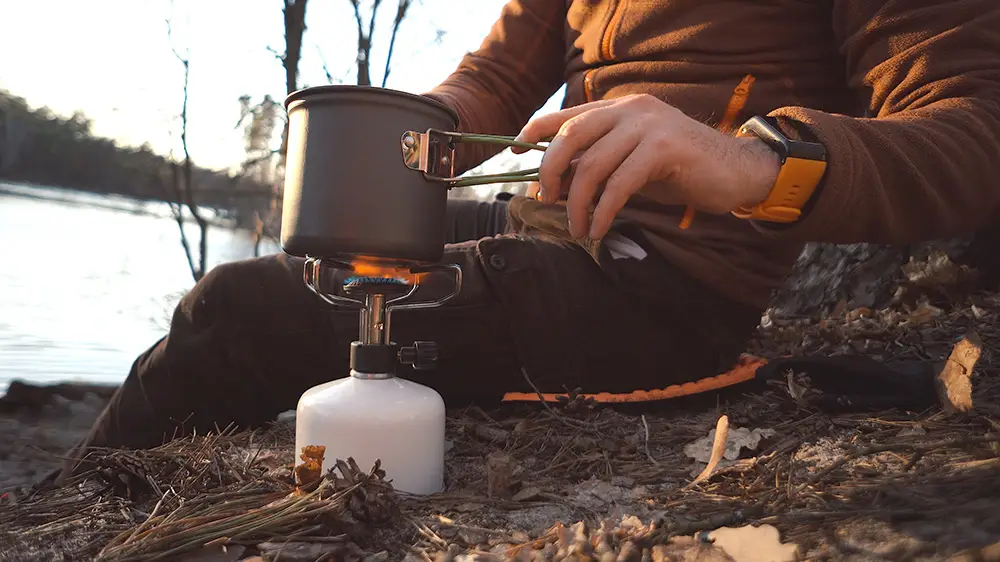Hiking Gear Explained
Learn how to prepare and train for your next hike, as well as hiking etiquette and trail preservation principles.
Home » Hiking 101: The Beginner’s Hiking Guide » Hiking Food Storage and Preparation Guide
Hiking Food Storage and Preparation Guide
When hiking, especially on longer trips, proper food storage and preparation are crucial. Not only does it ensure you have energy and nutrition, but it also helps protect wildlife and the environment. Whether you’re heading out for a day hike or a multi-day adventure, here’s a guide to preparing and storing food on the trail.

"Focus on lightweight, high-energy foods that are easy to pack without cooking."
Food Preparation for Day Hikes
For a day hike, food preparation is straightforward since you’ll only need enough meals and snacks for a few hours. Focus on lightweight, high-energy foods that are easy to pack and eat without cooking.
– Snack Ideas: Trail mix, energy bars, dried fruit, nuts, jerky, and pre-packaged snacks are all easy to carry and provide a quick boost of energy.
– Lunch Options: Sandwiches, wraps, or tortillas with spreads like peanut butter, hummus, or cheese are good options. Fresh fruit like apples or oranges also travel well.
– Hydration: Carry enough water in a hydration bladder or water bottles. You can also bring electrolyte powders to add to your water to stay hydrated.
Since you’re not cooking on a day hike, food prep is minimal. Just be sure to pack food that won’t spoil quickly and can be eaten without heating.

Food Preparation for Overnight Hikes
On longer, overnight trips, food preparation becomes more complex, requiring lightweight, calorie-dense meals that are easy to cook. This often involves using portable stoves or other cooking methods.
– Portable Stoves: A small backpacking stove, such as a canister stove (e.g., MSR PocketRocket or Jetboil) is lightweight and easy to use for boiling water or cooking simple meals. All you need is a fuel canister, a pot, and a lighter.
– Dehydrated Meals: Pre-packaged dehydrated meals are a popular choice for overnight hikes. These meals require only boiling water and can be eaten straight from the bag, making cleanup easy.
– Simple Cooking: For a more DIY approach, you can cook foods like instant rice, pasta, couscous, or oatmeal. Adding a protein source like pre-cooked sausage, tuna pouches, or dehydrated vegetables can turn these simple foods into a complete meal.
– Snacks and Breakfast: Instant oatmeal, granola bars, and dried fruits make for quick and easy breakfasts. During the day, snack on high-energy foods like nuts, chocolate, and jerky.
Food Storage for Hikes
Proper food storage is critical, especially for overnight trips where you’ll be camping in wildlife habitats. Improperly stored food can attract animals, which poses a danger to both you and the animals.
Animal-Safe Food Storage
– Bear Bags: In areas with bears or other wildlife, it’s essential to store your food in a bear bag. A bear bag is hung from a tree branch at least 10-12 feet off the ground and 4-6 feet away from the tree trunk. This deters bears, raccoons, and other animals from reaching your food.
– Bear Canisters: In some locations, like national parks, bear canisters are required. These hard plastic containers are designed to be bear-resistant and keep food safe. They also protect toiletries and other scented items.
– Odor-Proof Bags: To further reduce the chance of attracting wildlife, store your food in odor-proof bags. These are typically used in conjunction with bear bags or canisters.
– Hanging Your Food: If you don’t have a bear canister or bag, you can still hang your food in a regular dry bag or stuff sack using the PCT (Pacific Crest Trail) method. This involves hanging the bag with a rope so animals cannot reach it.
Storage for Day Hikes
For day hikes, you likely won’t need a bear bag or canister unless you’re hiking in a known bear territory. In most cases, a basic food bag or dry bag will suffice. However, always follow local regulations and guidelines, especially in wildlife-rich areas.
Leave No Trace
When hiking, it’s essential to follow Leave No Trace principles. Pack out all food scraps, wrappers, and packaging. Even biodegradable food like fruit peels or cores can disrupt local wildlife and ecosystems.
Food for Thought
Proper food preparation and storage are vital for a successful and safe hiking experience. For day hikes, focus on easy-to-pack, nutritious snacks, while overnight trips require lightweight cooking options like stoves and dehydrated meals. Be mindful of wildlife by using bear bags, canisters, and odor-proof bags, ensuring your food stays safe and you don’t attract animals. Always pack out everything you bring in to protect nature for future hikers.
Table of Contents
Plan trips
Who are we?
get in touch!
© 2025. All rights reserved. No part of this website may be reproduced without written permission.
